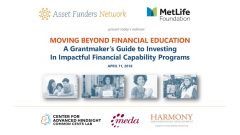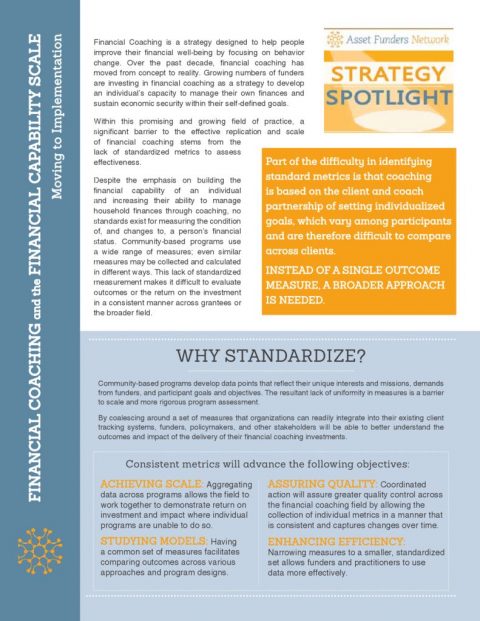Watch the Webinar from April 11, 2018.
For decades, practitioners and grantmakers have tried various approaches to help people realize their financial goals and improve their financial health. For much of that time, financial education was believed to be the best approach, and it proliferated in classrooms, online, at workplaces, and in other settings. Over the years, those involved in the work began to question whether or not these efforts were leading to long-lasting changes in financial behavior, especially for low-income and working families—the very people philanthropy and nonprofits most want to help. Numerous research studies now make it clear that financial education training alone does not result in behavior change.
Yet, glimmers of success occur on a regular basis through community-based financial capability programs. There’s the young man who started with $25 in his savings account with his first summer job and ended up with over $17,000 across multiple savings and retirement accounts. There’s a single mom who avoided foreclosure, took college classes, landed her dream job, and now mentors other community members. And, there’s a first-generation immigrant family who worked hard to establish and build their credit scores so they could open their own childcare business.
What led to the success of these individuals? What does the research indicate that facilitates real change in financial behaviors? Can we identify some best practices to guide future investments? The webinar and resource guide help address these questions and more.
The Common Cents Lab, part of the Center for Advanced Hindsight at Duke University, and Asset Funders Network (AFN), developed Moving Beyond Financial Education: A Grantmaker’s Guide to Investing in Impactful Financial Capability to aid grantmakers in assessing the efficacy of financial capability programs, and want to make strategic investments focusing on financial capability interventions that go beyond increasing knowledge to changing participants’ behaviors.
April 2018 Webinar Speakers
Wendy De La Rosa, Co-Founder and Principal (report author)
Common Cents Lab, Center for Advanced Hindsight
commoncentslab.org | wendy@commoncentslab.org
Christi Baker, Program Officer (report author)
Asset Funders Network
assetfunders.org | christi@assetfunders.org
Lucy Arellano, Director, Asset Building Programs
Mission Economic Development Agency (MEDA), San Francisco, CA
medasf.org | larellano@medasf.org
Katherine Denise Johnson, Executive Director
Harmony Neighborhood Development, New Orleans, LA
www.harmonynola.org | kdjohnson@harmonynola.org
Selected Webinar Q&A responses
Links to the Behavioral Audit for practitioners in both English and Spanish:
- This link provides the audit in both Spanish and English https://duke.qualtrics.com/jfe/form/SV_7P1k0dSW4ANesct
The meta-analysis of financial education programs cited on slides and in the brief was for which target audience(s)?
- Low-income adults.
- Shawn Cole and Gauri Kartini Shasti of Harvard Business School analyze the effectiveness of state-mandated financial education high-school courses on financial market participation. Those who graduated just prior to the imposition of mandates (and therefore were not exposed to financial literacy education) have identical stock market participation rates as those who graduated following the mandates (and were therefore exposed to the program).
What does changing the environment mean?
- Changing the program so that it’s behavior focused.
How can the field better standardize evaluation?
- Aligning on the key measures that matter – savings, housing, expense reduction, credit score, etc.
- Understanding that to test your program and evaluate your program in an effective manner, you need a true comparison group. An easy way here is to randomize participants at sign-up and measure outcomes.
Specific to individuals, what was the strategy utilized that ensured individuals were open and willing to participate and not shutting down during the process due to strong emotions associated with dealing with financial issues?
- There is not a lot of research on this. At its core, this is about building trust and making sure that the language is not focused on the past (“this is how bad you’ve done”) but is focused on the present (“This is what we are going to do together”). The more important focus is to make sure participants believe that you are on their team.
- LIFT has a customer voice/net promoter score model and has found that it’s about not making people feel bad. They ask a question similar to “Did you feel respected and treated with dignity” and find that clients who said “yes” were significantly more likely to complete their sessions and achieve their goals (https://www.liftcommunities.org/content/uploads/2016/12/Listening-Better_Dec-2016.pdf).
Is there research that reflects on the impact of increasing financial well-being to a whole community, instead of focusing on individuals?
- There is a great research showing the impact of states mandating financial education in high school curriculum and the impact of those cohorts on stock market participation. Shawn Cole and Gauri Kartini Shasti of Harvard Business School analyze the effectiveness of state-mandated financial education high-school courses on financial market participation. Those who graduated just prior to the imposition of mandates (and therefore were not exposed to financial literacy education) have identical stock market participation rates as those who graduated following the mandates (and were therefore exposed to the program).
- Although it’s difficult to measure community well-being, Family Independence Initiative (FII) is good at looking at community level (https://www.fii.org/). Also see: the Bank On and National League of Cities city-level approaches.0
What are some of the demographics of those 800 people tested? Are all testers low-income?
- Participants were making less than $75,000 yearly income in household income
- 46% female / 54% male
- Average age: 34.1
- 68% report making less than $50,000 per year
- 64% did not have children
- 26% live alone, 32% live with one other person, 41% live with 2 more people
- If living with other people, on average, they were responsible for 52% of household expenses
What other practitioners are doing this work?
- See the Common Cents Lab’s annual report
- BECU and ideas42 (http://www.ideas42.org/blog/project/financial-health-check/).
- National Federation for Community Development Credit Unions ( http://www.cdcu.coop/initiatives/pathways-to-financial-empowerment/).
- See MetLife Foundation’s Multipliers of Prosperity site –http://partners.wsj.com/metlife/multipliers/






